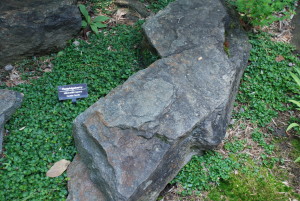Partridge berry (Mitchella repens) is cherished for its evergreen foliage, spring flowers and fall-winter colorful berries (USDA Zones 4–8). This native groundcover is frequently spotted in moist woodlands along banks of streams and on dry slopes in the eastern and central North America as far west as Minnesota and south to northern Texas and Florida. This ground hugger is a good addition to shade gardens.
Small, four-petalled, tubular white flowers are formed in pairs and are seen spotted above the foliage in mid-spring. Up close, flowers are fragrant; they may re-bloom lightly in fall. Broad rounded half-inch bright green leaves form a dense cover year round on the woodland floor. The leaves are paired oppositely on stems and have a distinctive pale yellow midrib.
Bright red berries that color and ripen in early autumn (in Tennessee) and remain thru winter. Set plants 6-8 inches apart and plan on 1-2 years for this evergreen woody vine to fill in. This non-climbing vine grows barely 2 inches high and creeps tightly along the ground. Stems grab into soil and stone crevices by adventitious roots.
Grow partridge berry in full or part shade and well-drained, acid soil. A soil pH range between 4.5 – 5.5 is ideal. It thrives in moist environs and falters in dry woodland soils. Disease and pest problems are rare.
It is usually propagated by cuttings or seed collected. Vines are collected for Christmas decorating. Partridge berry is frequently seen growing in a cool humid terrarium. Red berries are edible, rather tasteless, but eaten by birds and other fauna. Partridge berry grows abundantly in Newfoundland and Nova Scotia where the berries are used to make jam.


 Posted in
Posted in 
